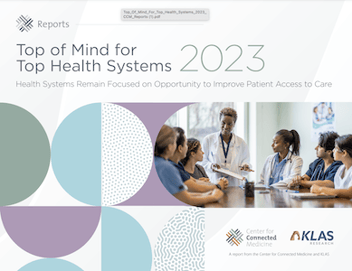One Good Reminder about Patient Experience from HCIC 2023
Two weeks ago at HCIC 2023 there was a great main stage session, Patient Experience Turned Upside Down: How Our Consumer Experience Approach Changed When Cancer Struck. We wanted to share a short recap of the session because there was a lesson in the content that was a great reminder—technology isn't always the answer.
Technology can do a lot of great things, but it can't, and shouldn't, do everything. And that is part of what the general session was about. The session description was,
"When Cris Ross, Chief Information Officer of the Mayo Clinic, and Ed Marx, former Chief Information Officer of the Cleveland Clinic, helped guide their organizations through digitally enabling patient experiences, little did they know that they would soon be the benefactors. When they both faced life-threatening illnesses, their long-term friendship helped them cope as they learned firsthand the key ingredients for a great patient experience. In this reality-based keynote, hear how they changed their mindsets and game plans to influence their respective organizations to turn the patient experience upside down. As they began their journeys into healing, they agreed to co-author a book based on their revelations as cancer patients and healthcare executives. In this keynote, get a sneak peek at The Patient Experience Turned Upside Down, set to release in late 2023. Cris and Ed share their research and reveal key findings that can help all health systems adopt a more consumer-focused approach to care. Leave the keynote with a customer friendly patient experience framework, understand the one key attribute common to most great patient experiences and leave with a checklist that every hospital should deploy regardless of size."
The overall gist of the presentation was simple: At the end of the day, we are in healthcare to help others. There are a lot of things an organizations can do, regardless of size, to improve the experience for patients. This is a list of things that don't require a Patient Experience Officer or huge investment. They just require leadership:
- Enable shared decision making
- Provide clear communication
- Focus on service not process
- Build a "village" or villages (i.e., it takes a village)
- Run healthcare as services not processes
- Create and sustain an empathetic organization with empathy training and modeling
- Create a patient-centric culture (volunteering, walking in their shoes)
This kind of change is the hard part. Moving away from checking boxes to focusing on the patient and their needs can be tough in healthcare. This is where tech can come in to help. According to Cris and Ed, the technology is the easy part. Learn from consumerism in other industries. No need to start from scratch. You can build an engaging digital front door with the tools and systems patients most want like easy access to find a provider or service, book an appointment, have a virtual visit, access medical records, etc.
Put these tools in place but focus attention on the hard parts like change management and building empathy and resiliency in your teams. All the profits from Cris and Ed's book, The Patient Experience Turned Upside Down, which will be out soon, will be donated to the Mayo Clinic Foundation to fight cancer.


